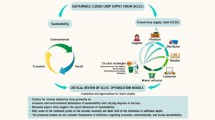Abstract
Manufacturing supply chains are considered as discrete event dynamical systems (DEDS) where coordination of material and information flows is essential to satisfy customer orders and to improve the bottomline of the constituent organizations. A critical problem that is often faced by distribution centres that hold finished good inventory is that of inventory rationing. Inventory rationing is a useful strategy to tackle the problem of conflicting objectives i.e., minimizing inventory costs (holding and backorder) on the one hand and achieving the desired customer service levels (CSLs) on the other. The focus of this paper is to formulate Generalized Stochastic Petri net models to address the inventory rationing problem in the context of multi-echelon make-to-stock distribution chains, where the goods flow through multiple echelons, typically from product manufacturers all the way up-to the retail outlets. The statistical inventory control (SIC) policies modeled by the GSPN are (R, s, S) and a variant that we propose, (R∗, s, S). We compare the performance of the model under two rationing settings. The first setting considers a case without cooperation, where the individual local stockpoints maximize their own performance. The second setting considers a case with cooperation, where the local stockpoints cooperate with each other to maximize the overall system performance. We provide a methodology to approximately determine the optimal rational fractions with different weights assigned to expected backorder and holding cost components (b/h). We present some interesting results obtained after rigorous numerical experimentation on the model.
Similar content being viewed by others
References
Chen, H., L. Amodeo, and L. Boudjeloud. (2003). “Supply Chain Optimization with Petri Nets and Genetic Algorithms.” In International Conference on Industrial Engineering and Production Management, Portugal, vol. 2, pp. 49–58.
Chen, H., L. Amodeo, and F. Chu. (2002). “Batch Deterministic and Stochastic Petri Net: A Tool for Modeling and Performance Evaluation of Supply Chains.” In IEEE International Conference on Robotics and Automation, Washington DC, vol. 1, pp. 78–83.
de Kok, A.G. (1990). “Hierarchical Production Planning for Consumer Goods.” European Journal of Operational Research 45, 55–69.
de Kok, A.G., A.G. Lagodimos, and H.P. Seibel. (1994). “Stock Allocation in a Two-Echelon Distribution Network Under Service Constraints.” Research Report No. TUE/BDK/LBS/94-03, Eindhoven University of Technology.
Eppen, G. and L. Schrage. (1981). “Centralized Ordering Policies in a Multi-warehouse System with Lead Times and Random Demand.” In L.B. Schwarz (ed.), Multi-level Production—Inventory Control Systems: Theory and Practice, Amsterdam: North-Holland.
Evers, P.T. (1999). “The Effect of Lead Times on Safety Stocks.” Production and Inventory Management Journal. Second Quarter, 6–10.
Haynsworth, H.C. and B.A. Price. (1989). “A Model for Use in the Rationing of Inventory During Lead Time.” Naval Research Logistics 36, 491–506.
Lagodimos, A.G. (1992). “Multi-Echelon Service Models for Inventory Systems Under Different Rationing Policies.” International Journal of Production Research 30, 939–958.
Raghavan, N.R.S. and N. Viswanadham. (2000). “Performance Analysis and Design of Supply Chains: A Petri net Approach.” Journal of the Operational Research Society 51, 1158–1169.
van der Heijden, M.C. (1997). “Multi-Echelon Inventory Control in Divergent Systems with Shipping Frequencies.” Technical Report P-5, Institute for Business Engineering and Technology Application (Twente).
van der Heijden, M.C. (1997). “Supply Rationing in Multi-Echelon Divergent Systems.” European Journal of Operational Research 101, 532–549.
van der Heijden, M.C., E.B. Diks, and A.G. de Kok. (1996). “Inventory Control in Multi-Echelon Divergent Systems with Random Lead Times.” Technical Report P-1, Institute for Business Engineering and Technology Application (Eindhoven/Twente).
Verrijdt, J.H.C.M. and A.G. de Kok. (1995). “Distribution Planning for a Divergent N-Echelon Network without Intermediate Stocks Under Service.” International Journal of Production Economics 38, 225–243.
Verrijdt, J.H.C.M. and A.G. de Kok. (1996). “Distribution Planning for a Divergent Depotless Two-Echelon Network Under Service Restrictions.” European Journal of Operational Research 89, 341–354.
Viswanadham, N. and Y. Narahari. (1992). Performance Modeling of Automated Manufacturing Systems. Englewood Cliffs, NJ, USA: Prentice Hall.
Author information
Authors and Affiliations
Corresponding author
Rights and permissions
About this article
Cite this article
Raghavan, N.R.S., Roy, D. A Stochastic Petri Net Approach for Inventory Rationing in Multi-Echelon Supply Chains. J Heuristics 11, 421–446 (2005). https://doi.org/10.1007/s10732-005-1855-2
Received:
Accepted:
Issue Date:
DOI: https://doi.org/10.1007/s10732-005-1855-2




